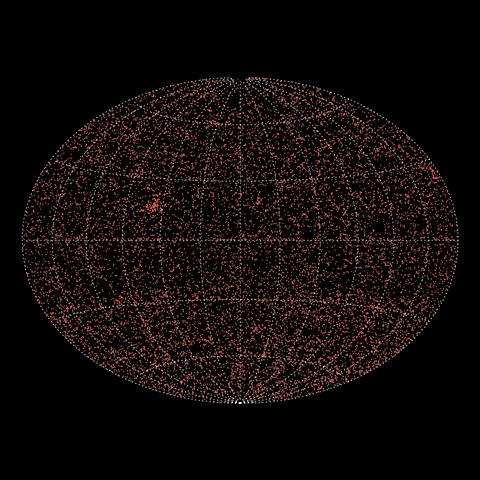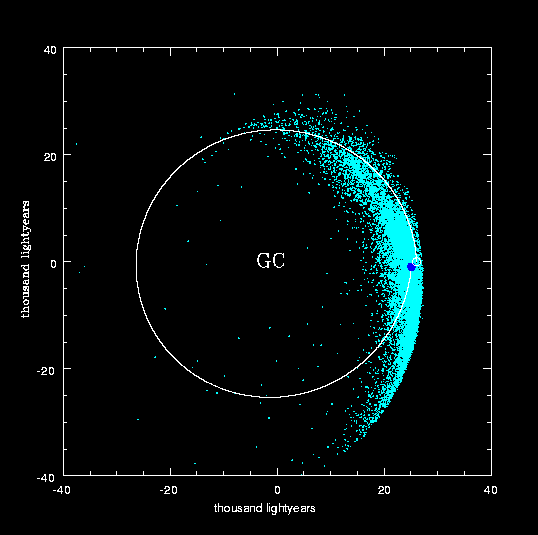Tales of a thousand and one nights... (6 April 2004)
- Details
- Published on 06 April 2004
Tales of a thousand and one nights: Past and future of the Milky Way
Released on April 6th, 2004
"The Geneva-Copenhagen survey of the Solar neighbourhood",
by B. Nordström et al.
This Press Release is issued as a collaboration between European Southern Observatory and Astronomy & Astrophysics.
The best way to understand our Milky Way as a whole is to study Sun-like stars (so-called F- and G-type stars), which are numerous and some of which have existed since the Galaxy's formation. The Danish- Swiss- Swedish team, led by Dr. Birgitta Nordström, has now determined the motions of about 14,000 F- and G-type stars - nearly all such stars in our neighbourhood. The figure below shows all of the observed stars projected on the sky.

All of the 14,000 observed stars projected on the plane of the sky.
To obtain this huge amount of data, Birgitta Nordström and her colleagues spent 1,000 observing nights over 15 years working with the Danish 1.5-m telescope at ESO La Silla Observatory, Chile, and the Swiss 1-m telescope at the Observatoire de Haute-Provence, France. In all, 63,000 single observations were made of the 14,000 stars - four times per star on average. Additional observations were made at the Harvard-Smithsonian Center for Astrophysics in Cambridge, Massachusetts, USA.
Most of the stars are located within about 500 light-years from the Earth and were already observed by the ESA satellite Hipparcos to measure their precise distances and motions in the plane of the sky. But a key piece was missing in our knowledge of their space motions in the Galaxy: The radial velocities [1] of the stars were still not measured, so only their 2D motions were known. The team of astronomers has now filled this gap: For the first time, we now know the 3D space motion of a complete sample of typical stars in the solar neighbourhood. From their space motions, the team was able to compute the positions of these stars at different points in the Milky Way's history. For example, the movie below shows the motions of the observed stars in their latest orbit around the Galactic Center.

The last orbit of the observed stars in their motion around the Galactic Centre (GC). Each orbit takes about 225 million years. The movie shows that the stars have travelled extensively in the disk of the Milky Way before converging into the small volume where we observe them today. The Sun is marked by a blue dot; its orbit by the white curve.
A first analysis reveals that objects in the galactic disk, such as molecular clouds, spiral arms, black holes, or possibly a central bar-shaped feature, stirred up the stellar velocities throughout the history of the Galaxy. This implies that the evolution of the Milky Way was far more complex and chaotic than traditional, simplified models have long assumed. Supernova explosions, galaxy collisions, and infall of huge gas clouds made the Milky Way a turbulent place indeed!
The velocities now published by the team are a veritable treasure trove for astronomers throughout the world who study the evolution of galaxies - one of the 'hot' topics in astrophysics today. This catalogue represents the most important improvement in our knowledge of our "home base" in the Milky Way since the results from Hipparcos appeared seven years ago. It will provide unique material for astronomers for years to come, until the vast database from ESA's satellite GAIA will become available around 2015.
[1] The radial velocities are measured from the Doppler shift of spectral lines in the stellar spectra. The same technique is used to detect planets around other stars.
The Geneva-Copenhagen survey of the Solar neighbourhood
by B. Nordström, M. Mayor, J. Andersen, J. Holmberg, F. Pont, B.R. Jørgensen, E.H. Olsen, S. Udry, and N. Mowlavi
Published in Astronomy & Astrophysics (DOI number: 10.1051/0004-6361:20035959)
Contact persons:
- Science:
Dr. Birgitta Nordström
Niels Bohr Institute for Astronomy, Physics and Geophysics
Juliane Maries Vej 30
2100 Copenhagen, Denmark
Phone: +45 353 25420 (Copenhagen) / +46 46 222 1572 (Lund) / +45 2875 5420 (mobile)
Email: This email address is being protected from spambots. You need JavaScript enabled to view it.
(Copenhagen) or This email address is being protected from spambots. You need JavaScript enabled to view it.
(Lund)
Dr. Johannes Andersen
Astronomical Observatory
Juliane Maries Vej 30
2100 Copenhagen, Denmark
Phone: +45 353 25934 - Email: This email address is being protected from spambots. You need JavaScript enabled to view it.
Dr. Michel Mayor
Geneva Observatory
51, Ch. des Maillettes
1290 Sauverny, Switzerland
Phone: +41 22 7 55 26 11 - Email: This email address is being protected from spambots. You need JavaScript enabled to view it.
- Press office:
Dr. Jennifer Martin
Journal Astronomy & Astrophysics
61, avenue de l'Observatoire
75014 Paris, France
Phone: +33 1 43 29 05 41 - Email: This email address is being protected from spambots. You need JavaScript enabled to view it.


